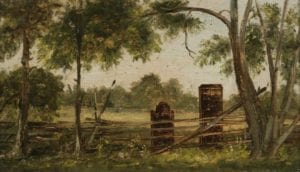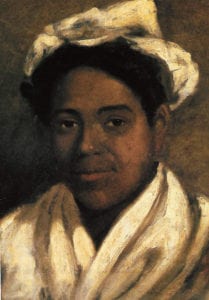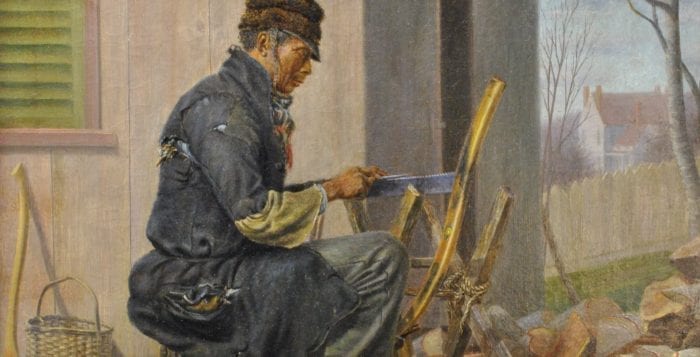By Heidi Sutton
After a brief hiatus, the Long Island Museum in Stony Brook reopened last weekend to showcase its latest exhibit, Long Road to Freedom: Surviving Slavery on Long Island, in honor of Black History Month.
Located in the Art Museum on the hill, the show is already receiving quite a lot of attention, evident by the many visitors who stopped by last Saturday. Jonathan Olly, who curated the exhibit, was pleased by the interest. “Part of the challenge of working behind the scenes is that we almost never spend time in the galleries so to see this is great,” he said as he fielded questions from guests.
The project, which took approximately five months of research, features more than 100 items, including paintings, photographs, artifacts, furniture and documents that are tied to Long Island’s slavery story. In addition to items culled from the LIM’s collection, many pieces from the exhibit are on loan from other museums, historical societies, libraries and private collectors.

Brought from Africa to New York by the Dutch and later by the English in the 1600s, slaves had an impact on every community on Long Island for the next 200 years. Landowners like the Smith, Hawkins/Mount, Townsend, Blydenburgh, Hewlett, Mills, Lloyd and Strong families used enslaved Africans and their descendants to manage their estates until New York State formally abolished slavery in 1827.
“If you were wealthy in the late 18th century on Long Island you were probably enslaving people,” said Olly. “Because that was what business was.”
“African-Americans have been part of the story of Long Island since the very beginning and they’re still here. Every historical society on Long Island has something that’s tied to their town’s story about slavery. This exhibit was an opportunity to bring all those pieces together and to see what kind of portrait it makes,” he said.
There’s a lot to take in.
As you enter the exhibit you are immediately greeted by William Sidney Mount’s most famous work, “Eel Spearing at Setauket,” on loan from the Fenimore Art Museum in Cooperstown. Last seen at the LIM in 1998, “It’s come home for a brief visit,” said Olly during a tour.
Commissioned by George W. Strong, the 1845 genre painting, depicting a young white boy and female slave by the name of Rachel Holland Hart fishing for eels with the Strong family estate in the background, is a fitting starting point for this important lesson in Long Island’s history.
“It’s a painting of a memory that Strong had as a child,” explained Olly. “The story is the relationship between African-Americans and English-Americans but with a warm glow over it. So it is a slavery painting, but it is a pleasant memory of that time told through this family (pointing to the boy) as opposed to this family (pointing to the woman) which I’m sure would have a very different perspective on that.”

Long Road to Freedom is told in sections, from when slavery began in New York in 1626 and follows its story for the next 200 years. In a stroke of brilliance, the exhibit is essentially split in half, with one side painted in a dark blue depicting the time of slavery, while the other is painted a light blue to represent freedom.
Visitors can view a door that came from the attic of the Joseph Blydenburgh home in Smithtown labeled “door to slave pen.” Notices from local newspapers offering rewards for runaway slaves line one wall, next to legal documents including bill of sales selling enslaved families and wills specifying what is to happen to the slave, who was part of the estate, after the owner’s death.
The exhibit also highlights the accomplishments of slaves, including poet Jupiter Hammon, whaler Pyrrhus Concer and author Venture Smith, and pays homage to the Quakers, the first group of people who decided that owning people was morally wrong. “The New York Quakers were really the first to question the institution of slavery and basically said, ‘If you want to be a Quaker in good standing you have to free your slaves,’” explained Olly, adding that they protested by not wearing cotton.
Two vignettes, located on either side of the room, reveal a full-size replica of the below-deck quarters of a slave ship complete with leg irons and a replica of what a typical African-American church would look like.
Two headstones retrieved from a former slave burial ground on the Mount property in Stony Brook are on display, engraved with loving epitaphs.
The entire experience can get quite emotional. “This is very heavy stuff,” agreed Olly.
Before leaving, visitors are invited to write down their thoughts. One card reads, “They were stripped of their name, their culture, their families, wholly opposite of any of our beliefs. This was an eye-opening exhibit.” It’s music to the curator’s ears. “That’s the best case scenario. The worst thing would be if people come through [this exhibit] and it doesn’t phase them at all,” said Olly. “You want it to touch people, to have something here resonate with them, and it looks like that is happening.”
The Long Island Museum, 1200 Route 25A, Stony Brook will present Long Road to Freedom: Surviving Slavery on Long Island through May 27. In conjunction with the exhibit, the museum will host a symposium on March 9 (see below) and a special screening of the documentary “Emanuel” on April 15 at 7 p.m.
Regular museum hours are Thursday through Saturday from 10 a.m. to 5 p.m. and Sunday from noon to 5 p.m. Admission is $10 for adults, $7 for seniors and $5 for students 6 to 17 and college students with I.D. Children under 6 are admitted for free. For more information, call 631-751-0066 or visit www.longislandmuseum.org.
Accompanying Symposium

Want to learn more? On Saturday, March 9 from 9:30 a.m. to 3:30 p.m. the Long Island Museum will present Long Road to Freedom: Surviving Slavery on Long Island, an all-day symposium exploring the experiences of African-Americans on Long Island across two centuries – from the travails of slavery to the blossoming of free black communities. Scholars will discuss the integral role of slavery in our region’s history and how African-Americans navigated between slavery.
Registration begins at 9:30 a.m. and topics of discussion include developing free black communities on Long Island; slavery, freedmen and the Quakers of Long Island; Setauket’s mixed heritage Native-American and African-American communities; gendered experiences in East End captivity and freedom; and lessons learned through Eastville, the Sag Harbor community formed largely by freed people of color. There will be a Q&A session immediately following the morning and afternoon sessions.
Presenters for the symposium include Jonathan Olly, curator of the museum’s Long Road to Freedom exhibition; Mary Elliot, museum specialist at the Smithsonian National Museum of African American History and Culture; Jennifer L. Anderson, associate professor of history at Stony Brook University; Lynda Day, professor of Africana studies at Brooklyn College; Christopher Matthews, professor of anthropology at Montclair State University; Allison McGovern, senior archaeologist at VHB Engineering, Survey, Landscape Architecture and Geology, P.C.; and Georgette Grier-Key, executive director and curator at the Eastville Community Historical Society and professor of Africana studies at Nassau Community College.
Those wishing to attend the symposium are asked to preregister by calling 631-751-0066, ext. 211 or email [email protected]. Registration fee is $12 per person plus $10 (optional) for lunch. Lunch is also available off-site at Stony Brook area eateries at participant’s expense.



 Topics of discussion include Pelletreau’s Life and Legacy, Pelletreau’s Larger World, American Craftsmen of the 18th Century and Pelletreau’s work in general from an artist’s point of view. There will be a Q&A session after the program, giving audience members the opportunity to ask specific questions of the presenters.
Topics of discussion include Pelletreau’s Life and Legacy, Pelletreau’s Larger World, American Craftsmen of the 18th Century and Pelletreau’s work in general from an artist’s point of view. There will be a Q&A session after the program, giving audience members the opportunity to ask specific questions of the presenters.


